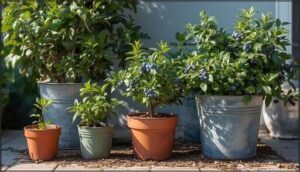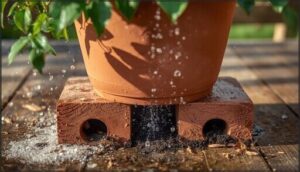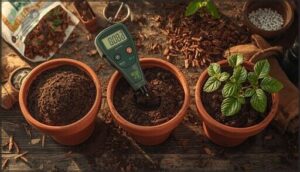This site is supported by our readers. We may earn a commission, at no cost to you, if you purchase through links.

Blueberries rank among the most rewarding fruits you can grow at home, yet many gardeners skip them entirely—convinced these shrubs demand sprawling garden beds and perfect conditions. That’s the myth keeping fresh, organic berries out of reach for apartment dwellers and small-space growers everywhere.
The reality? Growing blueberries in pots transforms these finicky plants into manageable, portable crops that thrive on patios, balconies, and even sunny doorsteps. Container cultivation gives you total control over soil acidity, drainage, and placement—the three factors that make or break blueberry success.
With the right container setup and variety selection, you’ll harvest handfuls of sweet berries from plants that adapt to your space instead of the other way around.
Table Of Contents
- Key Takeaways
- Choosing The Best Containers for Blueberries
- Selecting Suitable Blueberry Varieties
- Preparing Acidic Soil for Containers
- Planting and Caring for Blueberries in Pots
- Harvesting and Maintaining Potted Blueberries
- Frequently Asked Questions (FAQs)
- Can you grow blueberries in containers?
- How to plant a blueberry bush in a pot?
- Can blueberries grow in pots?
- Why do blueberries grow in containers?
- Can I grow a blueberry bush in a 5 gallon bucket?
- What does Epsom salt do for blueberries?
- How long do blueberry plants live in pots?
- What not to plant next to blueberries?
- When do blueberry bushes start producing fruit?
- How often should I fertilize container blueberries?
- Conclusion
Key Takeaways
- Container cultivation gives you complete control over soil pH, drainage, and placement—the three critical factors that determine whether your blueberries thrive or fail in pots.
- Choose compact varieties like ‘Top Hat’ or ‘Sunshine Blue’ in 15-20 gallon containers with proper drainage, since width matters more than depth for shallow-spreading blueberry roots.
- Maintain acidic soil between 4.5-5.5 pH using a custom mix of 40% peat moss, 40-50% sandy soil, and regular sulfur amendments to keep your plants productive year after year.
- Plan for 6-8 hours of daily sun exposure and consistent moisture checks, since container-grown blueberries demand more attention to watering and fertilizing than their in-ground counterparts.
Choosing The Best Containers for Blueberries
Your container choice sets the foundation for thriving blueberry plants, so you’ll want to get the size and setup right from the start. The right pot isn’t just about depth—it’s about material, drainage, and how easily you can move it when seasons shift.
Let’s walk through what makes a container work for blueberries and how to set yours up for long-term success.
Recommended Container Sizes and Depths
You’ll want containers at least 18 to 24 inches deep and wide for mature blueberries—think 15 to 20 gallons for highbush varieties. Width matters more than extreme depth since roots spread shallow.
Start younger plants in 2 to 5 gallon pots, then graduate them up as they grow. Adequate soil volume drives root growth and prevents those frustrating root-bound tangles that choke productivity.
For peak growth, consider the soil management tips to secure healthy blueberry plants.
Material Options and Weather Resistance
Once you’ve nailed size, consider material carefully—each manages weather differently. Plastic durability shines in freeze-thaw cycles without cracking, though dark colors overheat roots in summer sun. Ceramic insulation stabilizes soil temperature but shatters when frozen water expands inside. Wooden containers breathe beautifully yet rot without cedar or redwood construction. Fabric pots drain fast but dry out quicker. Concrete strength wins for extreme climates—heavy, stable, and nearly indestructible through scorching heat or bitter cold. Understanding the essential soil pH levels is vital for blueberry growth in containers.
Key material considerations:
- Plastic: Retains soil moisture well, resists weather extremes, but may overheat in direct sun
- Ceramic: Offers excellent root insulation and stability, though vulnerable to frost cracking
- Wood: Provides natural temperature control with proper rot-resistant species like cedar
- Fabric: Promotes exceptional aeration but requires more frequent watering
- Concrete: Delivers unrivaled durability and temperature protection despite limited mobility
Importance of Drainage and Elevation
Material choice sets the stage, but drainage systems determine success. Your container must have holes—without them, waterlogging suffocates roots and triggers rot.
Elevation methods matter too: prop containers on bricks or pot feet so water exits freely. This simple step enhances soil aeration and root health dramatically.
In container gardening, good drainage transforms your soil mix from saturated disaster to thriving potted plant paradise where blueberries flourish through proper soil preparation.
Placement for Easy Movement and Protection
Once drainage is solid, think mobility. Position your container gardens where you’ll actually reach them—patios and doorways beat remote corners every time.
Smart container placement protects blueberries while simplifying winter care:
- Equip pots with wheels for quick relocation during harsh weather
- Shelter near walls or structures to shield plants from wind protection needs
- Raise on stands to deter pests and manage soil temperature
Small space gardening thrives when you can move plants freely, use bird netting easily, and access them for pest control.
Selecting Suitable Blueberry Varieties
Not all blueberry varieties thrive in containers, so choosing the right type sets you up for success from the start. Your selection depends on your climate zone, available space, and whether you’re planting one bush or several.
Let’s look at the key factors that’ll help you pick varieties perfectly suited for pot growing.
Dwarf and Compact Varieties for Pots
Not all blueberries belong in pots—but dwarf cultivars do. Your variety selection determines container gardening success. Compact growth in cultivars like ‘Top Hat’ (2 feet) or ‘Sunshine Blue’ (3-4 feet) maximizes fruit yield without overwhelming your space. Self-pollinating types simplify blueberry plant care for beginners, though pairing varieties boosts production. Choose wisely, and you’ll harvest 5-10 pounds per season.
| Variety | Mature Height | Key Features |
|---|---|---|
| Top Hat | 2 feet | Self-pollinating, ideal for balconies |
| Sunshine Blue | 3-4 feet | 5-10 lbs yield, zones 5-9 |
| Silver Dollar | 2-3 feet | Two harvests yearly |
| Bountiful Blue | 3-4 feet | Large sweet berries |
| Northsky | 2-3 feet | Cold-hardy to -45°F |
Climate and Zone Considerations
Before growing blueberries in containers, you’ll need zone mapping that matches varieties to your local climate—not every cultivar survives where you plant. Northern highbush thrives in zones 4-7 with 800-1,000 chill hours, while southern types need zones 6-10 with fewer chill requirements. Temperature tolerance varies dramatically by development stage, demanding frost protection during bloom when even 28°F damages flowers.
- Full sun exposure (6-8 hours) maximizes fruit production in any zone
- Microclimate creation near buildings shields plants from temperature extremes
- Soil pH between 4.5-5.5 remains critical across all growing zones
- Afternoon shade prevents stress in hot summer regions above 104°F
Self-Pollinating Vs. Cross-Pollinating Varieties
Your pollination choice shapes container gardening success. Self-pollinating blueberries produce fruit alone but yield smaller berries with fewer seeds—cross-pollination boosts fruit size by 20-30% and accelerates ripening.
Plant two compatible varieties in separate pots for vigorous cross-pollination, or accept reduced berry size with single plants. Pollinator access remains critical either way, directly impacting seed production and harvest weight.
Preparing Acidic Soil for Containers
Getting your soil right is half the battle when growing blueberries in containers. These plants are picky about pH levels and won’t thrive in regular potting mix, so you’ll need to create an environment that mimics their natural acidic habitat.
Let’s look at three key steps to prepare soil that keeps your blueberries healthy and productive.
Creating Custom Acidic Soil Mixes
To realize your blueberries’ full potential, you’ll need a soil pH between 4.5 and 5.5. Start with an acidic mix combining 40% peat moss, 40-50% sandy soil, and 10-20% non-alkaline compost.
Peat moss offers natural acidity and moisture retention. For soil pH management, apply elemental sulfur at 1-2 pounds per 100 square feet, adjusting based on testing.
Maintain organic matter content around 40-50% to foster healthy root development.
Enhancing Drainage and Moisture Retention
Your container gardening success hinges on balancing drainage systems with moisture control. Add perlite or pine bark to your acidic soil mix—aim for 30% air-filled porosity to maintain root health and soil aeration. This prevents waterlogging while keeping moisture available.
Raise containers on bricks so excess water escapes freely. For water management, mulch the surface to reduce evaporation without compromising soil pH stability.
Adding Organic Matter for Plant Health
Blueberries thrive when soil organic matter reaches 4% to 7%, fueling microbial activity and nutrient cycling that synthetic fertilizers can’t match. This amendment strengthens your plant’s fibrous roots while maintaining the pH balance essential for blueberry health—all without disrupting proper soil preparation for blueberries or overwhelming beneficial soil microbes.
Mix peat moss or decomposed pine bark into your acidic soil to boost carbon sequestration and improve soil structure.
Planting and Caring for Blueberries in Pots
Once your container and soil are ready, it’s time to get your blueberry plants in the ground and establish a care routine that keeps them thriving. Success hinges on timing your planting right, meeting their sunlight needs, and staying consistent with water and nutrients.
Let’s walk through the essential steps to give your potted blueberries the best start and keep them productive for years to come.
When and How to Plant Blueberries
For the best start in container gardening, aim to plant your blueberry plants in early spring after the last frost, or by mid-October in fall.
Prepare acidic soil with a pH between 4.5 and 5.5, then position the plant at its original nursery depth. Water thoroughly after planting and place containers where they’ll get frost protection and promote strong root development.
Sunlight and Shade Requirements
Once your blueberry plants are settled in, they’ll crave six to eight sunlight hours daily to fuel photosynthesis rates and boost fruit production. Full sun exposure transforms container gardening success—you’ll see larger, sweeter berries when growing blueberries in ideal light intensity.
- Afternoon shade helps prevent leaf scorch in hot climates
- Shade tolerance varies; highbush varieties need more sun than lowbush types
- Artificial lighting (LED grow lights) can supplement insufficient natural sun
- Less than six hours reduces berry yield notably
Watering and Fertilizing Practices
Your plants need consistent moisture—check the top inch daily and water thoroughly until it drains. Container gardening demands more attention to water balance than ground planting.
Fertilize every four to six weeks during the growing season with acid-forming options that maintain soil pH between 4.5 and 5.5. Soil acidity determines nutrient cycling success when fertilizing blueberries.
| Irrigation Methods | Fertilizer Types |
|---|---|
| Daily hand watering | Ammonium sulfate |
| Drip irrigation systems | Cottonseed meal |
| Self-watering containers | 4-3-4 or 7-7-7 blends |
| Moisture meter monitoring | Elemental sulfur amendments |
Mulching and Pruning for Healthy Growth
Once your fertilizing blueberries routine is solid, you’ll want to focus on two container gardening tips that transform your blueberry bush from surviving to thriving. Here’s your action plan for mulch benefits and pruning techniques:
- Layer 4-6 inches of pine needles to retain moisture and suppress weeds
- Remove 30% of weak branches annually for stronger fruit production
- Create a vase shape when pruning to improve airflow
- Refresh mulch as it decomposes to maintain soil health
These practices support root development while growing blueberries in containers successfully.
Protecting Plants From Wind and Cold
When winter winds threaten your container gardening success, you’ll need a strategic defense plan. Shield your blueberry plants using these wind protection and cold insulation methods:
| Protection Method | Temperature Range | Best Application |
|---|---|---|
| Burlap wrapping | -10°F to 28°F | Freeze damage prevention during bloom |
| Burying containers | -20°F to -30°F | Winter care for dormant plants |
| Straw mulching (4-8″) | Below 28°F | Frost prevention and soil management |
Move pots to sheltered locations before temperatures drop, ensuring your plants meet their chill hours while avoiding winter protection emergencies.
Harvesting and Maintaining Potted Blueberries
After months of nurturing your potted blueberries, you’ll finally get to enjoy the fruits of your labor—literally. Knowing when your berries are ready to pick and how to protect your plants year-round makes all the difference in your harvest quality and plant longevity.
Let’s walk through the essentials of harvesting, pest management, winter care, and keeping your container blueberries thriving for seasons to come.
Recognizing Ripeness and Harvest Timing
You’ll know your berries are ready when they shift from shiny purple to a deep, matte blue with that telltale powdery bloom. Ripe blueberries detach easily with a gentle roll of your thumb—no tugging needed.
Wait 5-7 days after they first turn blue to let sugar content peak. Remember, blueberries don’t ripen after picking, so timing matters for maximum sweetness in your container gardening setup.
Let blueberries sit 5-7 days after turning blue—they don’t ripen after picking, so patience maximizes sweetness
Common Pests and Disease Management
Container blueberries face threats from blueberry maggot flies, spider mites, and aphids that can devastate your harvest. Fungal infections like mummy berry and root rot thrive in poorly drained pots, making disease prevention critical for fruit gardening success.
Effective pest and disease management includes:
- Yellow sticky traps and bird netting for insect management and fruit protection
- Base watering only to keep foliage dry and prevent fungal infections
- Natural predators like ladybugs as organic solutions for pest control methods
Winter Protection Strategies
Your blueberry plants need serious freeze protection once temperatures drop below 20°F. Container gardening exposes roots to brutal cold that in-ground plants never face, making winter protection essential for blueberry plant care and dormancy care success.
Implement these winter care strategies:
| Protection Method | Purpose |
|---|---|
| Bury pots in ground to rim | Root insulation through earth contact |
| Apply 4-12 inches of straw mulch | Winter mulching for temperature stability |
| Group containers against sheltered walls | Cold framing effect reduces wind exposure |
| Move to unheated garage or shed | Freeze protection without breaking dormancy |
Water consistently until soil freezes, then wrap pots in burlap for additional protection.
Refreshing Soil and Repotting as Needed
Soil acidity drifts over time, demanding your attention. Test pH annually and refresh the top 2-4 inches of potting mix each year to maintain that critical 4.5-5.5 range.
Full repotting every 2-3 years resets soil renewal completely—tease roots apart, prune the outer inch, and replant in fresh acidic mix. This root pruning and soil management keeps your container gardening thriving for decades.
Frequently Asked Questions (FAQs)
Can you grow blueberries in containers?
You’ve hit the nail on the head—blueberries thrive in containers when given proper care. Container gardening offers space-constrained growers real blueberry plants with impressive yield expectations, proving cost effectiveness despite variety limitations for successful container blueberry success.
How to plant a blueberry bush in a pot?
Start by gently loosening roots through root pruning, then position your blueberry plants at proper planting depth in acidic soil mix.
After initial watering, avoid soil compaction while considering variety mixing for better pollination.
Can blueberries grow in pots?
Yes, you can achieve potted blueberry success even with space constraints. Container gardening tips and proper care enable blueberry plants to thrive in urban gardening settings, proving blueberry potting feasibility for anyone.
Why do blueberries grow in containers?
Container gardening strategies reveal urban gardening success: blueberries thrive in pots because you gain complete soil control, space efficiency on balconies, mobility options for weather protection, and pest reduction—advantages traditional plots can’t match.
Can I grow a blueberry bush in a 5 gallon bucket?
A 5-gallon bucket can sustain dwarf blueberry varieties, though you’ll face bucket size limits on growth.
Expect regular root pruning necessity and diligent watering bucket blueberries plus fertilizing bucket blueberries to compensate for restricted soil volume.
What does Epsom salt do for blueberries?
Think of Epsom salt as magnesium insurance for your blueberry plant. Soil testing reveals deficiencies that foliar application corrects, boosting chlorophyll production.
However, over-application risks disrupting soil acidity and mycorrhizal impact, reducing nutrient absorption in container gardening.
How long do blueberry plants live in pots?
Blueberry plants in pots often thrive for 8 years or more, but factors like container size, frequent soil maintenance, repotting, and winter protection play a big role.
With attentive plant care, your container gardening efforts can keep them productive longer.
What not to plant next to blueberries?
Avoid planting brassicas, nightshades like tomatoes and potatoes, asparagus, lavender, grasses, and aggressive groundcovers near blueberries.
These companions create nutrient competition, disrupt soil pH and acidity, trigger allelopathy, increase pest transmission, and cause root disruption.
When do blueberry bushes start producing fruit?
Most blueberry plants begin fruit production two to three years after planting, reaching peak yields around six to eight years.
Container-grown varieties follow similar fruiting timelines when you provide proper chill hours and adequate pruning during early maturity stages.
How often should I fertilize container blueberries?
Your container-grown berries thrive with regular feeding every 4-6 weeks during spring and summer.
Apply acidic fertilizer formulated for azaleas, adjusting frequency based on container size—smaller pots need biweekly applications.
Conclusion
Picture yourself stepping outside on a summer morning, plucking sun-warmed berries straight from your patio—that’s the freedom growing blueberries in pots delivers. You’ve learned the essentials: acidic soil, proper drainage, smart variety selection, and seasonal care.
Now it’s simply a matter of putting container to soil and watching your investment grow. Those first harvests will taste sweeter knowing you created ideal conditions from scratch, proving that impressive yields don’t require sprawling gardens—just strategic planning.
- https://extension.umd.edu/resource/growing-blueberries-containers
- https://hort.extension.wisc.edu/articles/growing-blueberries-containers/
- https://extension.oregonstate.edu/catalog/ec-1304-growing-blueberries-your-home-garden
- https://extensionpubs.unl.edu/publication/ec3078/2025/pdf/view/ec3078-2025.pdf
- https://www.naturehydro.com/news/should-i-repot-my-blueberry-plant-every-year











